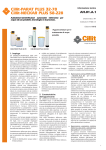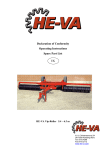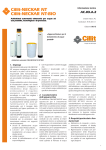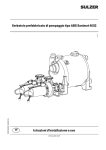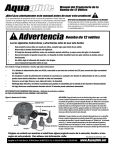Download PYLE Audio PEMP-6 Operating instructions
Transcript
15975190EN (05/2015) 1060-00 Lifting Station Type ABS Nirolift Lifting Station Type ABS Sanisett EN Installation and Operating Instructions www.sulzer.com 2 Installation and Operating Instructions Lifting Station Type ABS Nirolift. Lifting Station Type ABS Sanisett. Lifting Station Type ABS Nirolift Lifting Station Type ABS Sanisett Contents 1General.................................................................................................................................................... 3 1.1Description............................................................................................................................................... 3 1.2 Application areas...................................................................................................................................... 3 1.3 Legal regulations covering the use of lifting stations for the pumping of faecal-free effluent................... 4 2Safety...................................................................................................................................................... 4 3Transport................................................................................................................................................. 4 4 Installation and dimensions (mm)........................................................................................................ 4 5 Set-up and Installation........................................................................................................................... 6 5.1 Installation of the collection tank.............................................................................................................. 6 5.2 Installation of the submersible pump........................................................................................................ 6 5.3 Discharge line.......................................................................................................................................... 6 5.4 Opening of the collection tank inlet ports................................................................................................. 6 5.5 Mounting of the upper fitting..................................................................................................................... 7 5.6 Level control............................................................................................................................................. 7 5.7 Location of power supply cable and float switch...................................................................................... 8 6Commissioning...................................................................................................................................... 8 7Maintenance........................................................................................................................................... 9 7.1 Maintenance of lifting stations in accordance with EN 12056.................................................................. 9 7.2 General maintenance hints...................................................................................................................... 9 Sulzer reserves the right to alter specifications due to technical developments Installation and Operating Instructions Lifting Station Type ABS Nirolift. Lifting Station Type ABS Sanisett. 3 1General 1.1Description The wastewater lifting stations Nirolift and Sanisett consist of a synthetic collection tank which is waterproof in accordance with EN 12050-2, together with a cover plate with odour-preventing filter and lockable floor inlet. The Sanisett is supplied with a junction piece for the discharge line and a bracket for the level control. The collection tank is supplied as standard with a number of closed-off inlet ports. The inlet ports DN 100 (Nirolift) and DN 100/150 (Sanisett) can be opened as required (see Figure 3). The wastewater entering via the inlet ports is collected in the collection tank. When a preset liquid level is reached then the submersible pump is started up either by means of the float switch fitted to the pump itself or connected into the control panel, and is switched off again when the tank is emptied. NOTE: 1.2 In the case of twin units installed in accordance with EN 12056, one submersible pump must be capable of pumping all the effluent. The second pump is only a stand-by unit. Application areas Synthetic, prefabricated, corrosion-resistant sump for Sulzer submersible pumps, designed for the automatic pumping of wastewater in accordance with EN 12056 from locations and areas below the backwash level. m This product is only suitable for removing clear and dirty water up to a water temperature of 40 °C or up to a maximum of 60 °C during short-term operation. If the system is fed water from units such as washing machines, then the maximum water temperature could be exceeded if the device is not equipped with discharge cooling or if this is not switched on, e.g. in order to save energy. This may cause damage to the pump or the pumping system. In such case Sulzer will not accept any guarantee or warranty claim. If necessary, contact the manufacturer of the device or devices provided for connection (e.g. washing machines) to obtain information on how to switch on discharge cooling. Our systems are checked in accordance with EN 12050 LGA and conform to the current standards. Also note that the maximum inlet temperature to the public sewer system is 35 °C and that you must ensure that the water is cooled accordingly. m These lifting stations may not be used for the collection or pumping of flammable or corrosive liquids. Effluent containing grease, petrol or oil should only be brought to the lifting station via a separation device. Examples of substances that should not be allowed into the tank: • Aggressive fluids such as acids, lyes (caustic soda) or salts. • Flammable liquids such as petrol, oil or phenols. • Commercial and agricultural waste. • Solid substances such as ash, rubbish, glass, sand, fibrous material, cardboard, paper towels, textiles, diapers, kitchen waste, coffee grounds, shredder waste. • Liquid substances that can harden, such as bitumen, cement, lime, lime milk (whitewash), mortar, potato starch, grease (edible oils and fats), synthetic resin, synthetic resin emulsion, tar, paint residues. • Cleaning agents, disinfectants. • Abrasive material. 4 Installation and Operating Instructions Lifting Station Type ABS Nirolift. Lifting Station Type ABS Sanisett. 1.3 Legal regulations covering the use of lifting stations for the pumping of faecal-free effluent. Automatically operated lifting stations are required if: -- the water level in the odour lock of the effluent source lies below the sewer backwash level. -- rainwater gullies are present where the upper edge of the inlet grid lies below the sewer backwash level. The sewer backwash level is the maximum possible water level in the public sewer network. Information on this can be obtained from your Local Authority. If the backwash level has not been fixed by the Local Authority, then the surface level of the roadway at the connection point is taken to be the level. The regulations also require that all wastewater which can cause offensive odours must be collected in closed, odour-tight, and free-standing collection tanks. The collection tanks must be vented by vent pipes which are brought above roof level. ATTENTION! The regulations of DIN 1986/100, EN 12050-2 and EN 12056 should be observed! 2Safety The general and specific health and safety guidelines are described in detail in the “Safety Instructions for Sulzer Products Type ABS” booklet. If anything is not clear or you have any questions as to safety make certain to contact the manufacturer Sulzer. This unit can be used by children aged 8 years and above, and persons with reduced physical, sensory, or mental capabilities, or lack of experience and knowledge, when they have been given supervision or instruction concerning the safe use of the device and understand the hazards involved. Children must not play with the appliance. Cleaning and user maintenance should not be performed by children without supervision. 3Transport m During transport the unit should not be dropped or thrown. 4 Installation and dimensions (mm) 1 Synthetic tank 10 Shut-off valve (accessory) 2 Wastewater pump Robusta (not supplied with tank, must be ordered separately) 11 Vent/cable pipe DN 70, lead to above roof level 12 Cable inlet, odour-tight 3 Bend (accessory) 13 Socket 4 Upper fitting (adjustable 360°) 14 Concrete 5 Cover plate with floor run-off and odour lock (only suitable for foot traffic). 16 Floor tiles 6 Two inlet ports DN 100 (Nirolift) 100/150 (Sanisett) 17 Motor connection cable 7 Discharge line for connection of P.V.C pipe; 40 mm (Nirolift), 50 mm (Sanisett) 18 Branch pipe (T-piece) 8 Seal to finished floor 1) 9 Discharge line. --- Approximate excavation dimensions 15 Screed Anti-siphon loop Installation and Operating Instructions Lifting Station Type ABS Nirolift. Lifting Station Type ABS Sanisett. 5 1061-01 DN 70 1) 285 755 364 280 600 280 300 DN 100 15 16 6 5 4 7 8 11 Ø410 12 18 10 130 max 14 13 17 R 1¼” 640 750 670 - 800 9 350 340 3 2 1 Ø530 1062-01 Figure 1: Nirolift installation example and dimensions 380 825 364 900 380 DN 70 1) DN 100 445 1100 14 15 16 438 6 5 4 8 13 17 12 18 10 7 11 Ø410 130 max DN 150 R 1½” 760 350 340 3 2 790 - 920 850 9 1 Ø690 Figure 2: Sanisett installation example and dimensions 6 Installation and Operating Instructions Lifting Station Type ABS Nirolift. Lifting Station Type ABS Sanisett. 5 Set-up and Installation 5.1 Installation of the collection tank Set the collection tank on a bed of sand, in a frost-free area, in the prepared opening of approximate dimensions 755 x 600 x 750 mm for Nirolift and 1100 x 900 x 850 mm for Sanisett, and ensure that it is horizontal in all directions. Place the tank in such a manner that the vent openings are in line with the chosen pipe directions. If due to the progress of construction work it is impossible to install the venting and pressure pipes before pouring of the concrete, place a polystyrene core between the tank and the intended wall to allow for installation later on of the pipes. NOTE: During concreting, the collection tank should be prevented from floating upwards and should also be closed off with the plastic cover. This will avoid the danger that the edge of the tank could be pressed inwards. If there is a danger of pressure arising due to ground water, then the waterproof concrete surround of the Sanisett collection tank must be laid at the same time as the cellar floor, and should be closed off tightly on all sides (including under the tank). The pipes must also be laid in the concrete. If there is no danger of ground water pressure then a gravel bed and cementing in of the upper portion of the collection tank is adequate. The Nirolift is not approved for use where groundwater is present. 5.2 Installation of the submersible pump The Nirolift has been designed for the fitting of submersible pumps Robusta 200, Coronada 250, and MF 154 / 324 / 334. The Sanisett has been designed for the fitting of submersible pumps Robusta 200, Coronada 250, IP 900, Piranha 08 / 09 and MF 154 / 324 / 334 / 354 / 404 / 504 / 804. A suitable installation kit should be chosen depending on the type of pump selected. NOTE: The connection or junction piece is already fitted in the Nirolift or Sanisett collection tank. Instructions for fitting of the submersible pumps are given in the leaflet supplied with the installation kit. 5.3 Discharge line The discharge line must be installed in compliance with the relevant regulations. DIN 1986/100 and EN 12056 applies in particular to the following: -- The discharge line should be fitted with a backwash loop (180° bend) located above the backwash level and should then flow by gravity into the collection line or sewer. -- The discharge line should not be connected to a down pipe. -- No other inflows or discharge lines should be connected to this discharge line. ATTENTION! The discharge line should be installed so that it is not affected by frost. The vent line is connected by means of a push-on sleeve to the vertical outlet at the top of the collection tank. It should be of constant cross-section (min. DN 70) and should have a continuous rise to above roof level. 5.4 Opening of the collection tank inlet ports 1063-00 Only inlet ports that are to be used are to be opened. Saw off as little as possible so that as much neck as possible is left for the plug connection (note the notch on the port neck). File down sharp edges inside and outside. Figure 3: Opening connection ports 5.5 Installation and Operating Instructions Lifting Station Type ABS Nirolift. Lifting Station Type ABS Sanisett. 7 Mounting of the upper fitting 1. Insert the white plastic installation cover (a) into the frame of the upper fitting. The cover is only suitable for foot traffic (see Figure 4). 2. Adjust the upper fitting in the tank opening until the edge of the rim is level with the finished floor. The rim should also be parallel with the wall or floor tiles. 3. When installation is complete remove the installation cover and insert the cover with siphon (b) into the frame. This cover is only suitable for foot traffic. Height adjustment up to 130 mm is possible by pushing in or pushing out the upper fitting. It is possible to increase the depth at which the collection tank is installed by the use of one sump extension piece. These extend the sump by 150 mm. (a) (b) Figure 4: Mounting of upper fitting Figure 5: Sanisett above-ground lid Level control The float switches required for the twin-unit Sanisett should be fitted into the collection tank at the correct level setting. ATTENTION! Press the float switch cable into the plastic swivel in the holding bracket at a distance of 15 mm between the float switch housing and swivel. The float must face away from the tank wall. When float switches are installed, Robusta pumps should be set to ”Hand” operation. The connection lines for the float switches should be connected to the control panel by a qualified person in accordance with their designated switching levels A and B, and the circuit diagram. 1064-01 5.6 1066-00 A maximum of one sump extension piece may be fitted. 1065-00 ATTENTION! 15 mm 15 mm * * A X Figure 6: Sanisett float switch installation (* cable ties) B 8 Installation and Operating Instructions Lifting Station Type ABS Nirolift. Lifting Station Type ABS Sanisett. 5.7 Location of power supply cable and float switch The connection cable for the pump is fed through the cable pipe and brought into the room where the power supply is located by means of a branch pipe (T-piece). The connection cable is fed through the slot in the cable inlet and the cable inlet itself is pushed firmly into the branch pipe. In the case of twin units the connection cables for the float switches should be laid in a similar manner to the pump power cable. 1. 2. 3. 4. Branch pipe (T-piece) Cable inlet Vent line Motor connection cable 1067-00 NOTE: Figure 7: Cable inlet 5.8 Installation of the control unit ATTENTION! The control unit should be fitted above possible flood level in a well ventilated room and in an easily accessible position. Protection Class of the control unit IP 54. The control unit should be secured at all fixing points. The fixing holes are accessible after unscrewing the lower housing cover. ATTENTION! Do not drill through the housing of the control unit itself. NOTE: A number of different control box models exist. Please check the wiring diagram/ instruction manual in the control box. 6Commissioning m The safety hints in the previous sections must be observed! Before commissioning, the unit should be checked and a functional test carried out. Particular attention should be paid to the following: -- Have the electrical connections been carried out in accordance with regulations? -- Is the motor overload switch correctly set? -- Have the power and control circuit cables been correctly fitted? -- Was the sump cleaned out? -- Have the inflow and outflows of the pump station been cleaned and checked? -- Is the direction of rotation correct, even if run via an emergency generator? -- Are the level controls functioning correctly? -- Are the required gate valves (where fitted) open? -- Do the non-return valves (where fitted) function easily? ATTENTION! Before commissioning, the collection tank should be cleaned of any large particles and filled with water. After commissioning, the lifting unit is normally operated with the selector switch in position “Auto”. Installation and Operating Instructions Lifting Station Type ABS Nirolift. Lifting Station Type ABS Sanisett. 9 7Maintenance c c Before commencing any maintenance work the unit should be completely disconnected from the mains by a qualified person and care should be taken that it cannot be inadvertently switched back on. Servicing must only be carried out by qualified personnel. To avoid danger if the power cable is damaged, it must be replaced by the manufacturer or its service agent or a similarly qualified person. m When carrying out any repair or maintenance work, the safety regulations covering work in enclosed areas of sewage installations, as well as good general technical pratices, should be followed. NOTE: The maintenance hints given here are not designed for “do-it-yourself” repairs as special technical knowledge is required. NOTE: A maintenance contract with our Service Department will guarantee you the best technical service under all circumstances. 7.1 Maintenance of lifting stations in accordance with EN 12056 It is recommended that the lifting station be inspected monthly and its function checked. In accordance with EN regulations, the lifting station should be maintained by a qualified person at the following intervals: •• in commercial premises - every three months. •• in apartment blocks - every six months. •• in a single family home - once a year. In addition, we recommend that a maintenance contract be taken out with a qualified company. 7.2 General maintenance hints Sulzer submersible pumps are reliable quality products, each being subjected to careful final inspection. Lubricated-for-life ball bearings, together with monitoring devices, ensure optimum pump reliability provided that the pump has been connected and operated in accordance with the operating instructions. Should nevertheless, a malfunction occur, do not improvise but ask your Sulzer Customer Service Department for assistance. This applies particularly if the unit is continually switched off by the current overload in the control panel, by the thermal sensors of the thermo-control system, or by the seal monitoring system (DI). Regular inspection and care is recommended to ensure a long service life. NOTE: The Sulzer service organisation would be pleased to advise you on any applications you may have and to assist you in solving your pumping problems. NOTE: The Sulzer warranty conditions are only valid provided that any repair work has been carried out in a Sulzer approved workshop and where original Sulzer spare parts have been used. 10 Installation and Operating Instructions Lifting Station Type ABS Nirolift. Lifting Station Type ABS Sanisett. Installation and Operating Instructions Lifting Station Type ABS Nirolift. Lifting Station Type ABS Sanisett. 11 Sulzer Pump Solutions Ireland Ltd. Clonard Road, Wexford, Ireland Tel. +353 53 91 63 200. Fax +353 53 91 42335. www.sulzer.com














